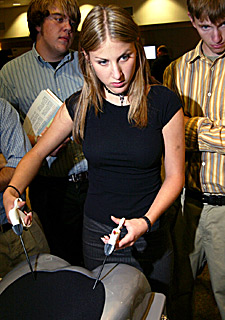 |
|
KEVIN KLAUS/Arizona Daily Wildcat
|
High school senior Ashley Muma uses a laparoscopic suture trainer during a surgery expo on Friday at the Arizona Cancer Center.
|
|
|
By Natasha Bhuyan
Arizona Daily Wildcat
Monday, April 19, 2004
Print this
The department of surgery is looking for new ways to cut into innovative medical technologies.
Along with the Arizona Surgery Club, the department hosted the Surgery Simulation Expo Friday to showcase various medical simulation machines.
The machines are mannequins that look and feel like real humans, complete with movement and internal organs. They can be programmed to suffer from various medical conditions, which doctors can practice curing.
Jo Marie Gellerman, public affairs coordinator for the surgery department, said the UA is developing a simulator laboratory this summer.
"These simulation centers are happening in universities all over the country," Gellerman said. "These skill labs are ways to train doctors efficiently and (the) UA sees the value in that."
The expo featured representatives from six top international medical simulation companies, which demonstrated intricate surgical procedures ranging from laparoscopic surgery to needle decompression.
Like pilots who train in flight simulators, the machines allow medical school students to train with simulated patients.
Patrick Brownd, global accounts manager for Simulab Corporation, displayed the company's "TraumaMan," which had a simulated skin layer participants could slice through to reveal blood and breathing lungs.
"The old adage goes, 'See once, do once, teach once,'" Brownd said. "But with simulation, you can do two or three times."
Chandan Kundavaram, a first-year medical student and president of the surgery club, said the simulators increase the amount of practice surgeons get, which will lead to better-trained doctors.
Peggy Stipe, western division sales manager of Medical Education Technologies, said her model speaks and comes with hundreds of profiles showing complete medical histories, including a truck driver who smokes, drinks and is suffering from a stab wound.
Dr. John Hughes, an associate professor of clinical surgery and a Vietnam War combat surgeon, attended the expo out of curiosity. He ended up performing a needle decompression on Laerdal Medical Corporation's "SimMan" and showing onlookers what to do when a patient has tongue edema (swelling) and pulseless electrical activity.
SimMan, which can be programmed in dozens of critical conditions, costs $30,000. But Kelly Swaim, territory manager for Laerdal, said the price pales in comparison to lawsuits inexperienced doctors must face.
"The question we need to ask is, 'How can we prevent as much as possible?'" Hughes said.
The department of anesthesiology owns one human patient simulator while the College of Nursing already has 11 similar mannequins and one virtual-reality simulator.
Mary Knowlton, coordinator for the Patient Care Learning Center in the College of Nursing, said they will receive $1 million June 1 to expand their lab. She hopes to purchase two more simulators.
"It enables us to assess students' critical thinking in a safe environment," Knowlton said. "We would much rather have them make a mistake here and never do it again."
Kamlesh Patel, a third-year medical student, said he had limited exposure to hands-on training his first two years of medical school and that the simulators would have been helpful in giving him an idea of real-life surgery.
"The simulators that offer tactile feedback are as close to real as you can get," said Eleazar Ley, a clinical assistant doing his residency in surgery. "It's a great investment for refining surgical skills."
Emer Norton, sales executive for Haptica, said her virtual-reality simulator concludes with an analysis of the performance of a doctor's hands, depth perception and hand-eye coordination. That lets doctors know what they should work on, she said.
The Arizona Surgery Club is an organization of nursing, medical and undergraduate students at the UA.
The group will be sponsoring a charity rock concert, SmileFest 2004, on April 30 at O'Malley's to raise funds for The Smile Train, a nonprofit organization that repairs cleft lip and palate in children in developing countries.
The concert, which begins at 7 p.m., will feature disc jockey J-Squared and the bands 7 Days of May, Dolemite Jones, The Craze and Visceral.
Tickets cost $5 and are available at the College of Medicine, the Graduate and Professional Student Council office, the Student Union Memorial Center and O'Malley's.
For more information on the Arizona Surgery Club, visit clubs.arizona.edu/~surgery.

